9 Best Running Shoes for Older Runners

The rhythmic pounding of feet on pavement. The cool morning air filling your lungs. The endorphin rush coursing through your veins. There’s something truly magical about running, and it’s an experience that shouldn’t be limited by age.
Sure, birthdays pile up, and maybe your knees don’t quite bounce like they used to. But that doesn’t mean you have to hang up your running shoes!
In fact, the benefits of running for older adults are numerous:
- Improved cardiovascular health: Studies show that regular running can lower blood pressure, cholesterol, and risk of heart disease.
- Stronger bones and muscles: According to report published on National Library of Medicine, running helps build and maintain bone density, reducing the risk of osteoporosis.
- Sharper mind and mood: Research has linked running to improved cognitive function and reduced risk of depression and anxiety.
- Boosted energy levels: Regular exercise can combat fatigue and leave you feeling energized throughout the day, according to article published on NLM.
But let’s be honest, running with “vintage mileage” comes with its own set of challenges. Those once-resilient joints might creak a little more, and finding the right balance between comfort and performance can feel like navigating a minefield.
That’s where the right shoes come in. Choosing the perfect pair of kicks can be the difference between a pain-free, invigorating run and a limping trip to the ice pack.
This is where we come in!
This blog post is your ultimate guide to finding the best running shoes for older runners. We’ll recommend shoes for different age groups within the “older runner” category, break down the key considerations, and offer pro tips to help you make the most of your runs.
So, lace up your enthusiasm, grab a healthy dose of determination, and get ready to hit the pavement with newfound confidence. Because age is just a number, and the joy of running is ageless.
Let’s get started!
List of Best Cushioned Running Shoe for Older Runners
Navigating the world of running shoes as an older runner is no small feat. Aching joints, changing balance, and a longing for effortless strides become paramount concerns.
But fear not, seasoned trailblazers!
We’ve handpicked three champions for each age group, designed to tackle your specific needs head-on with features that pamper and empower:
Note
Our team has conducted extensive research to curate this list of running shoes. We have collected data from a diverse group of testers, reviewers, and buyers from various sources, including blogs, YouTube videos, Reddit posts, and e-commerce platforms, to ensure that our recommendations are based on a wide range of experiences.
We believe that the data collected from hundreds of real-life customers who have used these products in various conditions is more reliable and unbiased than the reviews from just a few hired testers.
| Best for Age | Title | Key Features | Check Price |
|---|---|---|---|
| Best for 50 to 60 Years Old | Brooks Ghost 15 |
|
Check Price |
| Best for 50 to 60 Years Old | Asics NovaBlast 3 |
|
Check Price |
| Best for 50 to 60 Years Old | HOKA Mach 5 |
|
Check Price |
| Best for 60 to 70 Years Old | New Balance Fresh Foam X 880v13 |
|
Check Price |
| Best for 60 to 70 Years Old | Brooks Adrenaline GTS 23 |
|
Check Price |
| Best for 60 to 70 Years Old | ASICS Gel-Kayano 30 |
|
Check Price |
| Best for Over 70 Years Old | Saucony Triumph 21 |
|
Check Price |
| Best for Over 70 Years Old | HOKA Bondi 8 |
|
Check Price |
| Best for Over 70 Years Old | Brooks Glycerin 20 |
|
Check Price |
Best Running Shoes for Older Runners – Video
9 Best Running Shoes for Older Runners
Best Running Shoes for 50 to 60 Years Old Runners:
1) Brooks Ghost 15 [Best Long-Distance Running Shoes for Older Runners]:
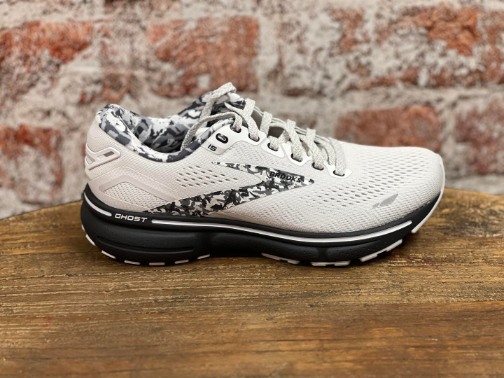
Check Price on Amazon
| Heel Drop | 12mm |
| Stack Height | Forefoot: 23mm | Heel: 35mm |
| Weight | Men: 286g | Women: 258g |
| Color Options | 32 Colors |
| Best For | Daily Training, Long-Distance Running, Jogging, Walking, Treadmill |
| Arch Support | Neutral |
| Terrain | Road |
As an older runner, you deserve a shoe that prioritizes comfort, support, and a smooth ride. The Brooks Ghost 15 ticks all these boxes and more, making it a top contender for your next running companion.
So, ditch the aches and pains, and get ready to experience the joy of running again with this trusted favorite.
Why Should You Buy?
- Plush Cushioning: The DNA LOFT v2 midsole in the Ghost 15 provides pillowy comfort and shock absorption on every stride that takes the pressure off your joints. Those miles will fly by without jarring your knees or ankles, letting you focus on the beauty of the run. These shoes are ideal for runners seeking reduced stress and protection on long-distance runs.
- Stable Platform: Say goodbye to wobbly ankles and hello to confident strides. The Ghost 15’s wider platform and 12mm heel-to-toe drop create a stable base that supports your natural heel strike. This design is especially beneficial for older runners who value stability and control.
- Smooth Transitions: Forget about clunky heel-to-toe transitions that send jolts up your legs. The Ghost 15’s Segmented Crash Pad ensures a smooth, effortless transition from heel strike to toe-off, keeping your run feeling fluid and comfortable.
- Secure Fit: No more blisters or hotspots interrupting your runs. The 3D Fit Print upper in the Ghost 15 wraps your foot like a glove, providing a snug, secure fit that eliminates distractions and lets you focus on the pavement ahead.
- Durable Construction: The Ghost 15 is built with high-quality materials and construction, ensuring it can withstand the demands of regular training. You’ll be investing in a shoe that lasts, saving you money and reducing your environmental impact.
- Adaptable Ace: Whether you’re a seasoned marathoner or a casual weekend runner, the Ghost 15 can keep up. Its versatility makes it suitable for various paces and distances, adapting to your training plan and preferences.
- Bonus:
Why Not To Buy?
- It is slightly heavier than its predecessor, weighing 286g for men and 258g for women.
- It lacks in breathability, especially in the toe box, compared to running shoes like the Saucony Triumph 20.
- It has a very high heel-to-toe drop of 12mm.
- Not optimized for forefoot strikers.
- Little arch support compared to the Ghost 14 (According to a couple of buyers).
Helpful Customer Reviews:
“I’m 76 yrs old, I jog 3miles a day and I have nothing but praise for this shoe. The sole on the Brooks 15 seems to be superior to previous models. Hopefully, it wears better but I am happy with the shoe.”
Review By Mttop
“Springy, bounce and wide. Brooks Ghost never disappoints. Especially for a 65 year old man!”
Review By TerryM
“Best runners ever purchased!! So pleased with them – as an 80year old I needed something secure and comfortable and the soft mesh front is perfect. I would totally recommend and I will certainly get another pair when needed.”
Review By Jennifer L
2) ASICS Novablast 3 [Best Daily Training Shoes for Older Runners]:
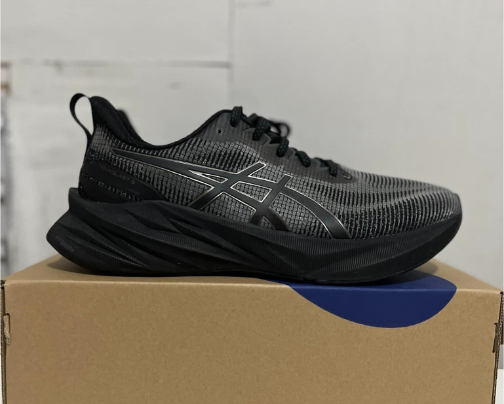
Check Price on Amazon
| Heel Drop | 8mm |
| Stack Height | Forefoot: 23mm | Heel: 31mm |
| Weight | Men: 252g | Women: 215g |
| Color Options | Men: 19 | Women: 19 |
| Best For | Daily Training, Jogging, Walking, All-day Wear |
| Arch Support | Neutral |
| Terrain | Road |
Let’s shift gears and explore another fantastic option for older runners – the ASICS Novablast 3.
This shoe takes a different approach to comfort and support, focusing on energy return and a springy, propulsive ride. Think of it as a bouncy castle for your feet, propelling you forward with each stride.
Why Should You Buy?
- Explosive Energy Return: Flyweight FlyteFoam Blast Plus cushioning packs a punch. This responsive midsole technology rebounds energy with every step, propelling you forward and reducing fatigue.
- Lightweight Agility: Ditch the heavy boots and embrace the featherweight (Men: 253g | Women: 222g) feel of the Novablast 3. Its minimal upper construction and streamlined design keep you light on your feet, promoting quicker transitions and easier runs. This is especially beneficial for older runners who might prefer a less bulky shoe.
- Enhanced Stability: Don’t be fooled by the bouncy feel – the Novablast 3 packs in hidden stability features. A wider platform and strategically placed overlays provide support and control, ensuring you move confidently even on uneven terrain.
- Breathable Comfort: Keep your feet cool and comfortable even on hot days. The engineered mesh upper of the Novablast 3 promotes excellent airflow, preventing sweaty, uncomfortable runs. This is crucial for older runners who might be more sensitive to heat.
- Versatile Performer: Whether you’re tackling short sprints or long-distance adventures, the Novablast 3 adapts to your needs. Its responsive cushioning handles both fast and slow paces, making it a versatile option for varied training plans and running goals.
- Bonus: Who says running shoes can’t be stylish? The bold and vibrant colors of the Novablast 3 add a touch of fun and personality to your runs.
Why Not To Buy?
- It has a significant stack height, which can provide ample cushioning but might lead to instability for some older runners.
- The shoe prioritizes responsiveness and energy return, which might not offer the same level of support and stability as some other ASICS models designed specifically for older runners, like the Kayano or GT series.
- Might not be a good options for older runners with wide feet.
Helpful Customer Reviews:
“I have been real happy with my Nova Blast 3… I was looking for a comfortable and cushioned running shoe and a friend suggested that I try the Nova Blast 3…from the moment I tried them on they did not disappoint…they are comfortable, stable and I immediately noticed a positive difference in my knees and feet! Love them…and by the way I am 72 years old, run two and sometimes three times a week totaling three to five miles per run…and that doesn’t include the many walks I take during the week…”
Review From Oregonia Ohio
“Best shoe just got better. Adding the thicker-grippier outsole makes the shoe even more stable without negatively affecting the superior ride/run quality. The “pop” is back. I’ve had all three versions now and must admit the Nova2, although I like it a lot”, lost some of the trampoline (pop) effect. the 3 has it back and the trail outsole grips well, especially going uphill. It bites into the soil, sand and snow quite well. The thicker outsole should wear well and give me more total miles of use than the regular 3’s outsole. I run moderate difficulty trails Fire roads and dirt trails in these with no stone bruises even though it does not have a bruise plate. Probably due to the thick mid-sole similar to the trabuco max. The de-coupled outsole snaps back nicely giving that bouncy-roll-onto-your-toe feeling again just like the original novablast. DO NOT PASS GO…BUY THIS SHOE!“
Review By Racine Wisconsin
“I have used different types of ascis, but never like the Novablast 3, the grip on the ankle, the tongue and the stability in the fall is great, I ran my first 5k and I did not feel discomfort on the soles of my feet. I am 65 years old and I will buy them again“
By Ignacio Hernandez
3) Hoka One One Mach 5 [Best Tempo Running Shoes for Older Runners]:
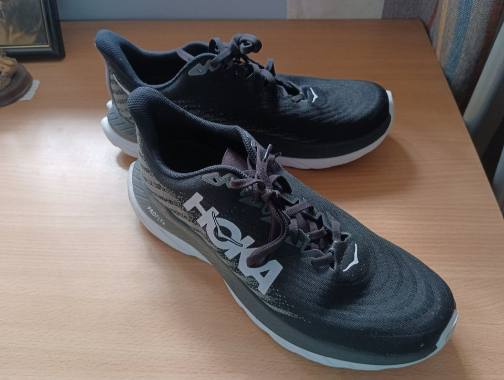
Check Price on Amazon
| Heel Drop | 5mm |
| Stack Height | Forefoot: 24mm | Heel: 29mm |
| Weight | Men: 232g | Women: 193g |
| Color Options | Men: 17 | Women: 13 |
| Best For | Daily Training, Treadmill, Jogging, Walking, All-day Wear, Tempo Running |
| Arch Support | Neutral |
| Terrain | Road |
For older runners seeking a blend of cushioning, support, and responsiveness, the Hoka One One Mach 5 stands out as a top contender.
Why Should You Buy?
- Cushioned Yet Energetic: The ProFly+ midsole strikes a golden balance between plush shock absorption and snappy responsiveness. Unlike the Ghost 15’s BioMoGo DNA, which prioritizes pure comfort, the Mach 5’s ProFly+ offers a touch of bounce-back, propelling you forward with each stride. Compared to the Novablast’s FlyteFoam Blast+, the Mach 5 delivers a slightly firmer yet more stable landing, ideal for aging joints.
- Support with Every Step: Stability doesn’t mean stiff! The Mach 5’s wide platform and Meta-Rocker geometry work in harmony with the ProFly+ foam to guide your foot through a naturally efficient gait cycle. This supportive structure surpasses the Novablast’s focus on lightweight agility, offering older runners better control and preventing inward rolling.
- Lightweight and Breathable: Despite its robust cushioning, the Mach 5 sheds unnecessary weight thanks to its “Creel Jacquard” engineered mesh upper and streamlined design. This translates to a lighter, more agile feel that won’t fatigue your legs prematurely on longer runs. The breathable mesh also keeps your feet cool and comfortable, preventing blisters and discomfort that can be more pronounced with age.
Why Not To Buy?
- Outsole requires improvement in terms of durability and slip-resistance
- Narrower toe box than some other Hoka models. This can be uncomfortable for older runners who have bunions or hammertoes
Helpful Customer Reviews:
“I’m 71 years old and have had hundreds of shoes. These are the best ever. Able to wear right out of the box. I volunteer at a a local hospital and spend hours on my feet. Normally the minute I get home, it’s shoes off. Not with these. I kept them on until bedtime and surprised myself that I wasn’t shoeless. This was my first pair of Hoka but not my last.”
Review By LG
“I am loving my Mach 5 Hokas! They fit true to size with plenty of room in the toe box. I am 64 years old, walking 6-12 miles a day, and this is the first shoe that I’ve worn that allows me to walk pain-free! I highly recommend the Mach 5 for walking!“
Review By Sue
Best Running Shoes for 60 to 70 Years Old Runners:
4) New Balance Fresh Foam X 880 V13 [Best New Balance Running Shoe for Older Runners]:

Check Price on Amazon
| Heel Drop | 10mm |
| Stack Height | Forefoot: 24mm | Heel: 34mm |
| Weight | Men: 300g | Women: 193g |
| Color Options | Men: 4 | Women: 5 |
| Best For | Easy Running, Treadmill, Jogging, Walking, All-day Wear |
| Arch Support | Neutral |
| Terrain | Road |
As the miles fly by and age brings new considerations, finding the perfect running shoe for your 60s and 70s becomes even more crucial.
The New Balance Fresh Foam X 880 V13 emerges as a strong contender, catering specifically to the needs of mature runners.
Why Should You Buy?
- Plush Sanctuary for Aging Joints: Fresh Foam X, New Balance’s latest iteration of comfort runs the length of the shoe, pampers your feet with pillowy softness. Each step feels like sinking into a supportive cloud, absorbing shock and shielding your precious joints from unnecessary stress. Unlike firmer shoes, the 880 V13 prioritizes pure, luxurious comfort, making even longer runs feel like gentle glides.
- Stability Reigns Supreme: Confidence thrives on stability, and the 880 V13 delivers it in spades. The wider platform and medial post work in perfect harmony, guiding your foot through a smooth, controlled gait cycle. This unwavering support prevents wobbles and inward rolls, a worry that might increase with age, empowering you to run with a steady, assured stride.
- Durability that Mirrors Your Spirit: Your running spirit knows no age, and the 880 V13 matches it step for step. Its robust construction, featuring a reinforced upper and wear-resistant NDurance rubber outsole, stands up to countless miles, ensuring your shoe remains your trusted partner for years to come.
- Bounce Back with Every Step: Don’t be fooled by the plush comfort; the 880 V13 isn’t just about sinking in. Fresh Foam X retains a surprising amount of bounce, propelling you forward with each stride. This gentle responsiveness keeps your runs feeling energetic, without sacrificing the comfort that your mature body craves.
- Fit Like a Familiar Friend: Your feet have been loyal companions through life, and the 880 V13 honors them with a comfortable, accommodating fit. The wider toe box provides ample space for any potential foot concerns, ensuring a snug yet non-restrictive feel that lasts mile after mile.
Why Not To Buy?
- Lack of side-walls or sole flare to enhace stability. (You can go for NB 860v13 for more stability)
- Good for easy running, jogging, and walking but not optimized for tempo runs
Helpful Customer Reviews:
“I run 8.5 miles every other day. I am 59 years old and have been running for 10 years. I’ve been using 880s since v10. they are a work horse and have helped me improve my half marathon mile time from 8 minutes to 7 minutes. I have logged four 8.5 mile runs in the v13s and they are perfect. the upper is even more comfortable and the tongue is a much better fit. The sizing is true. The cushioning is still there with a feeling of more responsive push off. The only problem with this shoe is that New Balance is going to have an almost impossible task of making a better version. **** and not only do i practice in these shoes, I run my half marathons and 5ks in them****“
Review By Anonymous
5) Brooks Adrenaline GTS 23 [Best Running Shoes for Older Runners with Plantar Fasciitis]:
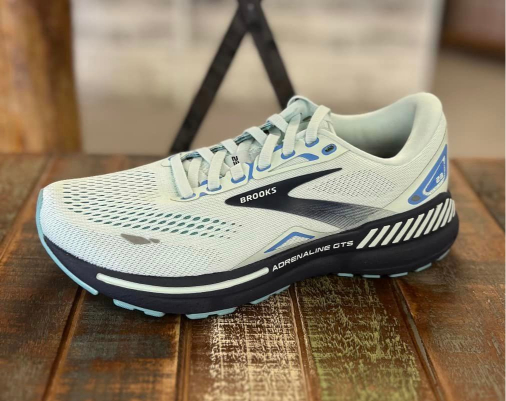
Check Price on Amazon
| Heel Drop | 12mm |
| Stack Height | Forefoot: 24mm | Heel: 36mm |
| Weight | Men: 286g | Women: 258g |
| Color Options | Men: 14 | Women: 16 |
| Best For | Daily Training, Aerobic Running, Jogging, Treadmill |
| Arch Support | Stability |
| Terrain | Road |
As the years add wisdom and silver to your hair, finding the perfect running companion becomes even more crucial.
The Brooks Adrenaline GTS 23 emerges as a trusted ally for your 60s and 70s strides, seamlessly blending support, comfort, and a touch of pep in your step.
Why Should You Buy?
- Guiding Light for Every Stride: Age might bring slight wobbles, but the Adrenaline GTS 23 stands guard. Its GuideRails® technology subtly guides your foot through its natural gait cycle, preventing excessive inward rolling and promoting smooth, stable strides. This gentle guidance alleviates the worry of imbalances, letting you focus on enjoying the scenery, not correcting your footfall.
- Plush Haven for Aging Joints: Every step on hard pavement sends vibrations up your legs. The Adrenaline GTS 23 combats this with its DNA Loft V2 and BioMoGo DNA midsole technologies, cleverly adapting to each impact and absorbing shock like a cushiony shield. This plushness protects your precious joints from unnecessary stress and gives adequate support if you are a Planter Fasciitis sufferer, making even longer runs feel comfortable and controlled.
- Supportive Structure, Lightweight Feel: Forget clunky support! The Adrenaline GTS 23 strikes a remarkable balance. Its engineered mesh upper securely wraps your foot, providing a reassuring hug without feeling heavy or restrictive. This lightweight construction lets you move with agility, conquering hills and exploring new paths with ease.
- Durability that Mirrors Your Resolve: Your dedication to running deserves a shoe that keeps up. The Adrenaline GTS 23 boasts a robust build, with a wear-resistant outsole and reinforced upper, ensuring miles melt away without compromising its supportive embrace.
- Energized Comfort, Mile After Mile: Who says comfort can’t be lively? The BioMoGo DNA midsole isn’t just about sinking in; it also offers a gentle bounce that propels you forward with each stride. This subtle responsiveness keeps your runs feeling energetic, preventing that slow-down you might expect from a purely cushioned shoe.
Why Not To Buy?
- A few loyal Brooks Adrenaline customers were disappointed with Adrenaline 23’s redesign, which made the shoe NOT true-to-size and width. A couple of reviewers also reported discomfort and blisters.
- A few testers reported that its engineered mesh isn’t as durable as it should be.
- May not be good for forefoot strikers due to high heel-drop and lack of forefoot cushioning.
- Not recommended for high speed running.
Helpful Customer Reviews:
“I love the Adrenaline 23! Im 56 years old. I had both knees replaced last year and these make me feel balanced and very stable! Hearing from other knee replacement folks, I tried on Hokas this year just to see if I liked them better. No way! Not as stable to me! I felt wobbly. I wore Brooks Adrenaline before my surgeries but this year’s model feel even better! I’m waiting to buy another pair, hoping for grey that goes it’s everything! I also like that these shoes are available through the military exchanges, although not many color options. Thanks Brooks! Let’s get a grey pair without black bottoms.”
Review By Shelly
“Best Shoes for Old Feet“
Brooks are the best shoes for my feet. I wear size 15 extra wide and I am 68 yrs old with minor feet problems. I can’t seem to find other shoes that feel like they fit right out of the box.”
Review By D. Martin
6) ASICS Gel-Kayano 30 [Best Running Shoes for Older Runners with Flat Feet]:
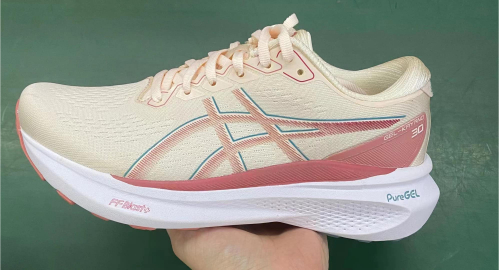
Check Price on Amazon
| Heel Drop | 10mm |
| Stack Height | Forefoot: 30mm | Heel: 40mm |
| Weight | Men: 303g | Women: 263g |
| Color Options | Men: 11 | Women: 11 |
| Best For | High-mileage Running, Daily Training, Walking, Treadmill, Jogging |
| Arch Support | Stability |
| Terrain | Road |
The ASICS Gel-Kayano 30 is more than just a running shoe for older runners – it’s a trusted ally on your journey to conquer every mile with confidence.
Why Should You Buy?
- Legendary Stability: Craving unwavering support? The Kayano 30 delivers. Its Dynamic DuoMax technology subtly controls inward rolling without feeling bulky, like a built-in guardian that lets you move freely. This unmatched stability is particularly beneficial for older runners who might experience increased pronation or balance concerns, ensuring every step feels controlled and protected.
- Responsive Cushioning: The FlyteFoam Blast+ midsole along with PureGEL technology in the heel area, provides a delightful balance between plushness and bounce. It absorbs impact like a cloud, shielding your joints from stress, while also propelling you forward with each stride. This responsive cushioning feels like a spring under your feet, making even uphill climbs a breeze and leaving you feeling energized, not exhausted.
- Unmatched Adaptive Stability: The Kayano 30 boasts the revolutionary 4D Guidance System. This unique feature dynamically adjusts to your pronation pattern throughout your stride, offering unparalleled stability without feeling restrictive. This feature is especially valuable for older runners who might have weakened ligaments or decreased proprioception, ensuring every step feels secure and confident, even on uneven terrain.
- Breathable Comfort: The engineered mesh upper keeps your feet cool and dry, even on hot days or long runs. This breathability is crucial for older runners who may experience reduced circulation or increased sensitivity to heat. Imagine running in a well-ventilated room, with your feet feeling fresh and comfortable mile after mile.
Comparison with Competitors:
- New Balance Fresh Foam X 880v13: While the Fresh Foam X 880v13 offers excellent comfort and stability, its medial post might feel more intrusive to some runners compared to the Kayano 30’s Dynamic DuoMax. Additionally, the Kayano 30’s FlyteFoam might provide slightly more responsiveness for those seeking a more energetic feel.
- Brooks Adrenaline GTS 23: Similar to the Fresh Foam X 880v13, the Adrenaline GTS 23 offers great comfort and stability with its GuideRails technology. However, the Kayano 30’s Trusstic system adds another layer of midfoot support, which could be beneficial for older runners who require extra control and protection.
Why Not To Buy?
- It has a stack height of 40mm in the heel and 30mm in the forefoot, which is higher than many other running shoes. This can make the shoe feel less stable for some runners, especially older runners who may have weaker ankles or balance issues.
- The Gel-Kayano 30 has a relatively stiff midsole, which can provide good support but may not be as comfortable for older runners who prefer a softer, more cushioned shoe. However, according to runners, the midsole gets flexible with time.
- A bunch of buyers claimed that “this shoe is a dirt magnet.”
Helpful Customer Reviews:
“I have used prior versions of the Gel Kayano and found them comfortable. Same for this latest generation. I am about 200 lbs, neutral gait, and this shoe provides comfort and cushioning. It’s also available in widths. I recommend it!”
Review By LA WB (Age: 65+)
“I have flat feet/over pronation and I need the fit, comfort and support and this shoe fits the bill. Love my ASICS and I’ll buy again.”
Review By Mr J (Age: 65+)
“I waited until I had some miles on my 30’s to write a review. This spring, I was told by our local running store staff that Asics was changing the Kayano to be similar to the Hoka. His words were, “It’s what the Hoka wishes it would be.” Truth be told, I was a runner since 1979 of all distances including marathons until 2011 when I had to make changes and switch to hiking, walking, and other types of physical activities. I still wore my Kayanos but needed more stability and cushion. So I switched to Brooks Ariels. I like Brooks Ariels, but were difficult to find in my size (11B or D) and a light color. So I thought it best to try another brand. A couple of times I tried Hokas but the pain in my feet, knee and especially my hip from the shoes was unbearable. I tried several models, none worked. That’s when the guy at the running store recommended I wait until the new Kayano 30 was released. When they were released, I went in, tried them on with my orthotics, and from Day 1 they have once again become my go-to shoe. Yes. I’m older. Yes. I have aches and pains here and there. But these shoes have once again made walking, doing intervals, and just plain wearing them and being comfortable a delight. Size Women’s 11W with orthotics”
Review By Walkingnana (Age: 65+)
Best Running Shoes for over 70 Years Old Runners:
7) Saucony Triumph 21 [Best Treadmill Running Shoes for Older Runners]:
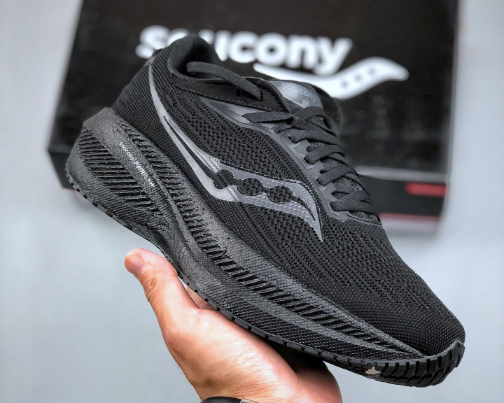
Check Price on Amazon
| Heel Drop | 10mm |
| Stack Height | Forefoot: 27mm | Heel: 37mm |
| Weight | Men: 279g | Women: 250g |
| Color Options | Men: 13 | Women: 15 |
| Best For | Daily Running, Training, Walking, Treadmill, Jogging, All-day Wear |
| Arch Support | Neutral |
| Terrain | Road |
For runners 70 and beyond, every step is a victory over time. Comfort becomes paramount, and the Saucony Triumph 21 stands tall as a champion in the realm of plushness and effortless movement.
Whether you’re logging daily miles, prepping for a race, or simply enjoying a leisurely walk, this shoe elevates every step with luxurious comfort and unwavering support.
Why Should You Buy?
- Cloud-Like Landings: Imagine sinking into a marshmallow with every stride with no more wincing after each step. That’s the feeling the Triumph 21’s PWRRUN+ and EVERRUN combo delivers. This luxurious midsole cushions impact like a dream, protecting your joints from the stress of pounding pavement.
- Effortless Strides: Say goodbye to stiff strides and hello to smooth transitions. The FormFit upper adapts to your unique foot shape like a warm embrace, providing a stable, comfortable ride that pampers your every step. Forget about feeling restricted or pinched; the Triumph 21 moves with you, not against you.
- Breathable Bliss: Even the most seasoned runner deserves cool, dry feet. The Triumph 21’s airy flat-knit mesh upper keeps your feet fresh and ventilated, mile after mile. No more battling sweaty discomfort!
- More Than Just Cushioning: While plushness reigns supreme, the Triumph 21 doesn’t compromise on support and stability. Its medial post guides your foot through each stride, preventing unwanted inward roll and promoting healthy alignment. The 10mm drop adds a natural feel, keeping your stride smooth and stable.
- Excellent Grip: The XT-900 outsole offers superior grip, while wider platform further enhances stability, giving you the confidence to tackle even uneven terrain.
Why Not To Buy?
- Its heel-to-toe drop is not favorable for forefoot strikers.
- Its wide design makes this shoe uncomfortable for runners with narrow feet.
- A few buyers complained that outsole’s treads started peeling off after 3-4 months of use.
Helpful Customer Reviews:
“This is a nice shoe, although pieces chip off the midsole and it’s difficult to clean. I got these as an alternative to the Hoka. I need a very cushioned show due to arthritis in my toe joint and these allow me to walk pain free. The Hoka broke down quickly and squeaked terribly. I’v had these for a couple of months and use them for walking. They are starting to flatten out a bit, but overall a nice shoe. The only drawback is the midsole material. Will likely buy another pair.”
Review By midlifecrisis
“I’ve been looking for an easy/recovery run shoe that’s lighter than most other shoes in this category and can also pick up the pace whenever I felt like doing so during such runs. I’m happy to say I found that with the Triumph 21. I have the Endorphin Speed 3 and Endorphin Pro 3 and they are great but I found them a bit narrow in the forefoot/toe-box and went up half-size. The Triumph 21’s toe-box is roomy and I got it in TTS and the fit is perfect. The upper is stretchy and conforms really well around the foot. I hadn’t tried the Triumph 20 specifically because I was a little worried about the upper comfort based on my experience with the Speed 3 and Pro 3. The upper, heel collar, and tongue are all very comfortable and almost plush feeling. The step-in feel is excellent. It makes me feel good about going on an easy long run. The midsole isn’t the softest or the bounciest out there but very well balanced – protective, comfortable, and responsive. It’s easy to keep a steady pace and lock in but, when I want to go faster, it responds nicely to the increased pace and rides smooth. The outsole is excellent with almost complete rubber coverage preventing wear on the midsole. The grip is probably as good as one needs it to be for daily runs although I have not run in wet conditions yet. I’m in SoCal so that probably won’t happen until the winter. Overall, the Triumph 21 is a very well-rounded shoe in that it’s great for the easy/recovery and long runs at a relaxed pace but can also handle faster medium-pace workouts as well. Very happy with the Triumph 21 and I highly recommend it.“
Review By RoadTrailRunner
8) Hoka One One Bondi 8 [Best Running Shoes for Heavy Older Runners]:
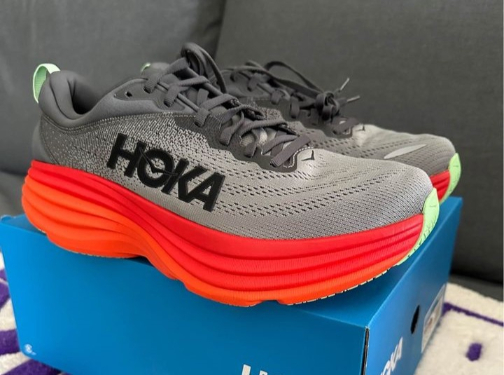
Check Price on Amazon
| Heel Drop | 4mm |
| Stack Height | Forefoot: 35mm | Heel: 39mm |
| Weight | Men: 311g | Women: 252g |
| Color Options | Men: 25 | Women: 19 |
| Best For | Daily Training, All-day Wear, Walking, Jogging, Treadmill |
| Arch Support | Neutral |
| Terrain | Road |
For older runners, defying time isn’t just about speed, it’s about the joy of effortless movement.
The Hoka One One Bondi 8 isn’t just a shoe, it’s a magic carpet for your feet, designed to let you conquer distance with cloud-like comfort and worry-free confidence.
Why Should You Buy?
- Maximum cushioning: The Bondi 8 features Hoka’s signature thick and soft EVA midsole, which provides ample cushioning and shock absorption for your joints. This is especially important for older runners who may be more susceptible to impact injuries.
- Meta-Rocker technology: The Bondi 8’s unique rockered midsole geometry promotes a smooth and efficient rolling motion through the gait cycle, which can help to reduce fatigue and improve overall running efficiency.
- Wide platform: The Bondi 8 has a wider platform than many other running shoes, which provides added stability and support for your feet. This can be helpful for older runners who may have balance issues.
- J-Frame technology: The J-Frame is a medial post that helps to guide your foot and prevent excessive inward rolling. This can be helpful for older runners who may be pronators.
- Vibram Megagrip outsole: The Vibram Megagrip outsole provides excellent traction on both wet and dry surfaces, which is important for older runners who may be more likely to run in challenging conditions.
- Heel Drop and Stack Height for Optimal Comfort: The Bondi 8 boasts a 4mm heel drop and a 39mm/35mm stack height, striking the perfect balance for older runners seeking maximum cushioning with a natural feel. This combination minimizes stress on your ankles and knees while providing ample support for a smooth, stable ride.
Why Not To Buy?
- Not recommended for runners with wide feet due to less-spacious toe-box and tight midfoot.
- Heavier than many running shoes.
- Not optimized for high-speed running.
Helpful Customer Reviews:
“I friend mentioned that she thought Hoka shoes were too wobbly on the top. I’ve found that is in some respects true, but not if the shoe is properly laced and secured. The bounce does take some getting used to. Especially at front of foot. I’ve run and walked in Nike Air Max for years and really liked my Zoom Pegasus. But overall, my new Hoka Bondi 8’s are comfortable and very easy on my knees. At 76 years old, I still run but mostly just walk vigorously. Hoka shoes were recommended to me by ultra-marathon runner friends years ago, and now I know why.“
Review By Judgejon
“I am 70 years old and wanted max cushioning for running. These shoes have exceeded my expectations for both comfort and cushioning. I am able to continue to run comfortably.“
Review By Razor
“As an older runner I appreciate the comfortable cushioning. I like the styling and available colors.”
Review By Rich
9) Brooks Glycerin 20 [Best Running Shoes for Beginners]:
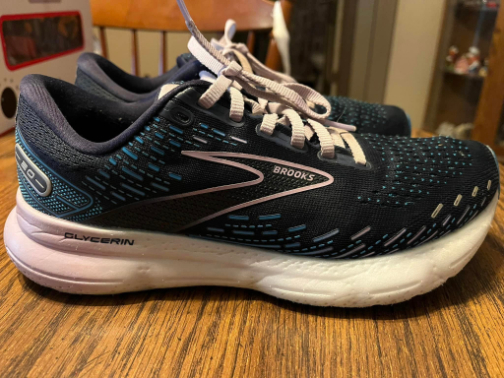
Check Price on Amazon
| Heel Drop | 10mm |
| Stack Height | Forefoot: 24mm | Heel: 34mm |
| Weight | Men: 286g | Women: 258g |
| Color Options | Men: 19 | Women: 15 |
| Best For | Recovery Running, Daily Running, All-day Wear, Walking, Jogging, Treadmill |
| Arch Support | Neutral |
| Terrain | Road |
For seasoned runners, age is just a number, and comfort becomes the king of the running kingdom.
The Brooks Glycerin 20 emerges as a champion of elegant plushness and smooth transitions, designed to make every mile a luxurious experience for discerning older runners.
Why Should You Buy?
- Nitrogen-Infused Comfort: Imagine sinking into a cloud that whispers sweet nothings about joint protection. The Glycerin 20’s nitrogen-infused DNA LOFT v3 midsole delivers on that promise. It absorbs impact like a plush mattress, shielding your joints from stress and fatigue, mile after mile. Forget the bone-jarring thuds of traditional supportive shoes; the Glycerin 20 cradles your every step with unparalleled softness.
- Silky Smooth Transitions: The shoe’s rocker design and DNA Loft cushioning are designed to promote a smooth and effortless heel-to-toe transition, which can help to reduce fatigue and make running more enjoyable.
- Amazingly Versatile: The Brooks Glycerin 20 is a versatile shoe that can handle almost any workout, from slow, long runs to speedwork, and can adapt to different surfaces and conditions. This can suit older runners who may have varying goals and preferences, and who may want a reliable and durable shoe that can last for multiple training cycles.
- Multiple Width Available: The Brooks Glycerin 20 has a comfortable, breathable, and supportive upper that fits true to size and comes in three different widths: medium, wide, and narrow. This can accommodate older runners who may have different foot shapes and sizes, and who may value comfort and fit over aesthetics.
- Bonus: Also available in GTS version for both Men and Women.
Comparison with Competitors:
- Saucony Triumph 21: Both the Triumph 21 and Glycerin 20 excel in plushness, but the Glycerin 20 offers a slightly smoother and more responsive feel due to its nitrogen-infused DNA LOFT v3 and focus on silky transitions. For runners desiring a touch more elegance and subtle support, the Glycerin 20 might be the better choice.
- Hoka One One Bondi 8: While both provide maximum cushioning, the Bondi 8’s rockered sole might feel too aggressive for some older runners who prefer a smoother, more neutral transition. The Glycerin 20’s focus on elegant comfort and subtle support might be a better fit for those seeking a plush yet natural-feeling experience.
Why Not To Buy?
- At 286g (10.1oz) for men and 260.8g (9.2oz) for women, the Glycerin 20 is not the lightest shoe on the market. This extra weight can be noticeable on longer runs and fatigue the legs faster for older runners with reduced strength.
- Compared to some other shoes designed for speed or tempo, the Glycerin 20 prioritizes comfort and cushioning over responsiveness. This may not be ideal for older runners who desire a bit more pep in their step or want a shoe that feels faster during races or intervals.
- A few buyers claimed that its laces get loose while running.
- According to the tests performed by RunRepeat, the Heel drop of this shoes is higher than advertised (Actual: 12.8mm, Advertised: 10mm).
Helpful Customer Reviews:
“As a 62 year old big man that works out and walks I love the soft walk feel. They breath nicely, are light and look good. My new favorite Brooks shoe.”
Review By Joel M.
“Great shoe for older runners/joggers/walkers
A great shoe for this old guy who is taking long power walks and slow jogs! After decades of running and two knee replacements and and ankle fusion, max cushioning with stability are a requirement for me, and these shoes give me both. One star withheld because of inferior laces which require a double tie to stay laced more than 10 minutes. My first day using them found me retying them twice mid-jog, on a 15 degree winter morning These top tier shoes deserve better laces and so does the buyer paying a premium price,”
Review By William M.
Key Considerations for Older Runners: Navigate Your Run Smoothly
While the joy of running remains ageless, our bodies adapt with time.
To embrace the miles confidently, older runners need to be mindful of certain considerations that impact comfort, performance, and injury prevention.
Foot Changes with Age:
- Widening feet: Feet tend to spread with age, requiring a wider toe box to avoid discomfort and blisters.
- Reduced flexibility: Decreased ankle and foot flexibility necessitate a shoe with good bending properties at the forefoot.
- Balance and stability: Age-related balance issues may benefit from stability shoes with features like medial posts or firmer midsoles.
- Joint pain: If you experience joint pain, especially in the knees or hips, opt for shoes with ample cushioning and shock absorption.
Let’s delve into the key factors to keep in mind as you lace up and hit the pavement:
1. Footstrike:
This refers to how your foot makes contact with the ground. Understanding your type of footstrike can influence shoe selection:
- Neutral: Your heel strikes first, followed by a natural rolling motion through the midfoot and forefoot. Most shoes cater to this common type.
- Overpronation: Your foot rolls inwards excessively, potentially causing instability. Look for shoes with medial support features to guide your foot to a neutral position.
- Underpronation: Your foot rolls outwards little to none, increasing stress on the ankle and outer forefoot. Opt for shoes with good cushioning and flexibility.
Consulting a podiatrist or a running store expert can help determine your footstrike and recommend shoes accordingly.
2. Foot Conditions:
If you have bunions, hammertoes, or plantar fasciitis, you’ll need shoes with specific features for those conditions. Consult a podiatrist for advice.
3. Cushioning:
As joints become less forgiving with age, adequate cushioning is crucial to absorb impact and reduce stress on your knees, ankles, and spine.
Consider shoes with softer, thicker midsoles, especially if you run on hard surfaces or prefer longer distances.
However, don’t get carried away – excessive cushioning can compromise responsiveness and feel “mushy.”
4. Support:
Stability features become increasingly important as balance and proprioception (awareness of body position) may decline slightly with age.
Look for shoes with features like medial posts or firmer arch support to counteract inward rolling and keep your foot in a neutral position.
5. Flexibility:
Opt for shoes that are flexible enough to accommodate your foot’s natural movements while providing stability. Try bending the shoe at the ball of the foot to test its flexibility.
6. Fit:
This is paramount for both comfort and injury prevention. Shoes should be snug but not constricting, with ample room for toe wiggle.
Wider toe boxes are often preferred by older runners for accommodating bunions or hammertoes.
Get professionally fitted at a store to ensure the perfect match for your foot shape and size. Trying on shoes with your running socks is also recommended.
7. Heel Counter:
A firm heel counter (the back part of the shoe that holds the heel in place) provides stability and reduces the risk of ankle rolling, especially important for older runners who may have stability issues.
8. Material:
Lightweight, breathable materials like mesh uppers can promote ventilation and prevent sweaty discomfort.
Additionally, consider shoes with seamless or welded constructions to minimize friction and potential rubbing against sensitive areas.
9. Outsole:
The outsole of a running shoe refers to the bottom part that comes in direct contact with the ground. Look for durable and high-traction outsoles, especially if you typically run on various terrains. Additionally, consider the tread pattern to ensure it suits your running surfaces—some provide better grip on trails, while others are designed for road running.
10. Easy to Break In:
Choose shoes that don’t require an extended break-in period. Flexible materials and designs that adapt well to your foot’s shape can make the breaking-in process more comfortable, reducing the risk of blisters or discomfort during initial runs.
11. Easy to Put On:
For older runners, especially those with mobility issues or joint stiffness, shoes with easy entry and a secure closure system are beneficial. Look for options with wide openings, elastic laces, hook-and-loop closures (like Velcro), or slip-on designs for convenience and ease of putting on and taking off the shoes.
12. Heel Drop:
The heel-to-toe drop or offset refers to the difference in height between the heel and the forefoot.
Some older runners may prefer shoes with a lower heel drop as they can encourage a more natural footstrike and potentially reduce strain on the Achilles tendon and calf muscles.
You can refer to our running shoes heel drop chart to find the shoe with most suitable heel drop.
13. Brands:
Popular brands for older runners include Brooks, New Balance, Hoka One One, Saucony, and Asics. They offer a wide range of shoes with features specifically designed for comfort and support.
14. Comfort Over Style:
While style is a factor, prioritize comfort and functionality over aesthetics. A good-looking shoe won’t be beneficial if it doesn’t provide the necessary support for your feet.
15. Personal preferences:
Consider preferred closure types (laces, velcro, etc.), sock-like uppers for a snug fit, and reflective elements for low-light visibility.
16. Running Surface:
Choose shoes specific to your preferred terrain, like road shoes for pavement or trail shoes for rougher surfaces.
Now that you’re equipped with the knowledge, go forth and conquer those miles!
Additional Tips:
- Shop late in the day: Feet swell slightly throughout the day, so try on shoes when your feet are at their largest.
- Bring your old shoes: The salesperson can compare them to your new ones and see if you need any changes in features.
- Test run: Walk and jog in the store to ensure the shoes feel comfortable and supportive.
- Don’t skimp on quality: Invest in a good pair of shoes that will last and protect your feet.
- Replace regularly: Most shoes wear out after 300-500 miles.
Remember: These are just general guidelines. Always listen to your body, adjust your training volume and intensity as needed, and consult a healthcare professional if you experience any persistent pain.
Don’t be afraid to try different brands and models to find your perfect match. What works for one runner might not be ideal for you. So lace up, hit the pavement, and discover the shoes that let you run with confidence and joy.

![Altra Heel To Toe Drop Chart [2024 Updated]](https://bestfashionnova.com/wp-content/uploads/2023/10/Altra-Heel-Drop-Chart.jpg)
![Brooks Heel Drop Chart [2024 Updated]](https://bestfashionnova.com/wp-content/uploads/2023/08/Brooks-Heel-Drop-Chart.png)
![New Balance Heel Drop Chart [2024 Updated]](https://bestfashionnova.com/wp-content/uploads/2023/09/new-balance-Heel-Drop-Chart.jpg)
![Under Armour Heel Drop Chart [2024 Updated]](https://bestfashionnova.com/wp-content/uploads/2023/10/Under-Armour-Heel-Drop-Chart.jpg)
![Running Shoes Heel Drop Chart [2024 Updated]](https://bestfashionnova.com/wp-content/uploads/2023/07/A-blog-post-banner-with-title-running-shoes-heel-drop-chart.jpg)
![Hoka Heel Drop Chart [2024 Updated]](https://bestfashionnova.com/wp-content/uploads/2023/10/Hoka-Heel-Drop-Chart.jpg)